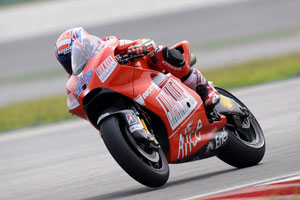Reaction to a slide may be the difference between saving a crash or having one. We look at how to keep in control.

The Benefits
As mentioned in the main copy, being prepared for the worst is the best way to ensure you maintain control at all times, but the real benefit of learning how to slide for racers or track day riders is for outright speed. You see, racers are searching for the limits constantly, and this is where understanding the levels that you can stretch tyre grip to is important.
A common problem among teams who use traction control in MotoGP and Superbike racing is that the electronics take away too much power, not enabling them to slide their way around the track. When the TC kicks in, if it’s set on too high of a level, the bike will basically slow down when a rider desperately wants to be accelerating.
TC basically reduces the required amount of input from the rider in order to find the balance between grip and wheelspin, but too much TC can really affect a rider’s lap times. This shows how important it is to get a good feel of grip levels on acceleration for those who are riding without TC.
Another bonus of sliding is that sometimes when you have a great feel for the bike as an experienced racer, you can even apply more throttle in order to turn that little bit tighter off the corner when it looks like you might be running wide. That’s a real technical skill right there, but it’s being done every single time you watch MotoGP or SBK racing.
You’re coming out of a corner and get a bit too confident on the throttle application. Before you know it the bike is beginning to break traction and any reaction from here on out might just be the difference between you correcting the slight error or crashing to the ground.
As we all begin to explore the limitations of both man and machine, it’s a very real possibility that breaking traction can, and most likely will, happen. It’s how you control the slide that is the important thing.
When I say exploring the limits, I don’t just mean by going out and riding like a maniac until the rear-end breaks loose. The limits could come unexpectedly if you ride over something slippery on the road’s surface, or sliding happens much easier in wet and raining conditions.
A good way to get a feel for sliding is actually by learning to do it on a dirt bike first, where it’s not so critical if you fall off while practicing because the speeds are mostly slower and the bikes don’t have fairings or anything too expensive to crunch.
Many riders are lucky enough to have grown up riding in paddocks or on race tracks as kids, essentially giving them the perfect breeding ground to work on their throttle control from a very young age.
If you never rode dirt before you began on the black top and don’t currently own a bike, do yourself a favour and go and hire a bike to get a feel for a bike really moving around.
This will not only help you ride safer in all circumstances, but for those who are looking to excel on the circuit it will give you a better feel between the connection of the throttle and the rear tyre like never before.
And that’s exactly what we’re all dealing with when accelerating out of a turn – the balance between going fast enough out of a corner by applying the correct amount of throttle, applying too little throttle, or getting too eager and putting yourself in a position to have an accident.
What you will learn to do on a dirt bike is get the feel of when applying the throttle, you will feel the more you twist the throttle then the more it will cause the rear tyre to break traction. The connection between the throttle and the rear tyre is a little looser on a dirt bike, mostly because the surface has more of a tendency to cause the rear wheel to slide.
On paper it’s simple. Don’t apply much (or should we say enough?) throttle and the bike will stay in line. Apply more throttle and you will feel the rear begin to drift out. If you do begin to slide, roll off the throttle and the bike will bring itself back into line pretty quickly.
Once you experiment on the dirt and feel comfortable with your new found drifting skills, aim to adopt those skills you learnt to your road bike. This is where it becomes more difficult because once again you’re on an expensive piece of equipment, and the road usually hurts more than dirt if you come unstuck.
It isn’t really your goal to get the bike sliding on the road like what I explained in the dirt skills, you more want to ride to the point where it’s about to slide, but without actually getting the rear to break loose. Or as I mentioned earlier, the techniques learnt on the dirt bike will work to your benefit if the unexpected does happen and all of a sudden you do find yourself crossed up sideways unintentionally.
Applying throttle hard off the corners will cause quite a bit of flex on road tyres before it loses traction, and that is a great thing to really try to get a feel for when riding on the road.
A key point when riding a road bike on the track or the road is that you really want to find a comfortable balance between twisting the throttle, sitting the bike upright, and straightening up off of the turns.
If you do this all in one smooth process then your transition from the apex of the corner to the straight will be much easier and safer. If done right, it will pretty much eliminate any problems of having the rear-end lose traction unexpectedly – allowing you to focus on maximum acceleration.
In a perfect world we’d all have super sticky tyres with perfect roads, but we don’t for now, so remember to get out and practice on a dirt bike and take it to the streets. Practice makes perfect, remember.






